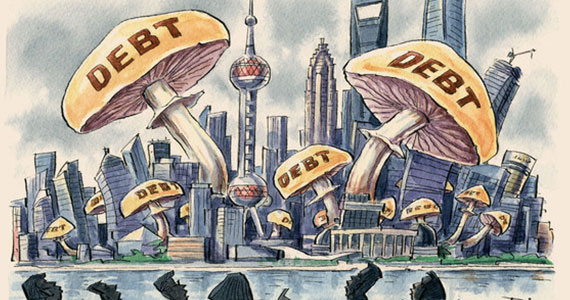Balance sheets matter. This is the biggest lesson of the financial crises that have rolled across the world economy. Changes in balance sheets shape the performance of economies, as credit moves in self-fulfilling cycles of optimism and pessimism. The world economy has become credit addicted. China could well be the next victim.
资产负债表很重要——这是席卷世界经济的一场又一场金融危机所带来的最大教训。随着信贷以自我实现的乐观/悲观周期起起伏伏,资产负债表的变化会影响经济体的表现。世界经济已变得对信贷上瘾。中国很可能成为下一个受害者。
If we think about balance sheets in the world economy of today, four questions arise. First, what determines vulnerability? Second, where are vulnerabilities now appearing? Third, how are countries coping with the legacy of old debt crises? Finally, can the world economy cope with the new vulnerabilities?
如果我们考虑当今世界经济的资产负债表,就会面对四个问题。首先,是什么决定了脆弱性?其次,眼下脆弱性在哪里显现?第三,各国正在如何应对老债务危机的后遗症?最后,世界经济能够应对新的脆弱性吗?

Start with the sources of vulnerability. In economies with liberalised financial sectors, the driver towards disaster is far more often private than public imprudence. Rising property prices and expanded mortgage lending drive many credit booms. A deterioration in the public sector’s balance sheets usually then follows crises. Failure to recognise this link between private excess and public borrowing is wilful blindness.
首先来讲脆弱性的来源。在具备自由化金融业的经济体,导致灾难的因素在更多情况下是私人部门(而非公共部门)的轻率。不断上涨的房价和扩大的抵押贷款,推动着许多信贷繁荣。危机爆发后,公共部门的资产负债表状况通常会恶化。不承认私人部门过分行为与公共借款之间的这种联系,乃是故意视而不见。
In an update of work on debt and deleveraging, McKinsey notes that between 2000 and 2007, household debt rose as a proportion of income by one-third or more in the US, the UK, Spain, Ireland and Portugal. All of these countries subsequently experienced financial crises. Indeed, huge increases in private sector credit preceded many other crises: Chile in 1982 was an important example of this connection.
麦肯锡(McKinsey)在一份有关债务和去杠杆化的最新报告中指出,2000年至2007年间,美国、英国、西班牙、爱尔兰和葡萄牙的家庭债务占收入比例上升了三分之一或更多。所有这些国家随后都经历了金融危机。的确,其它许多危机爆发之前也曾出现私人部门信贷的大幅增加:1982年的智利是展示这种联系的一个重要例子。
Ruchir Sharma of Morgan Stanley argues that the 30 most explosive credit booms all led to a slowdown, often a crisis. A rapid change in the ratio of credit to gross domestic product is more important than its level. That is partly because some societies are able to manage more debt than others; it is partly because a sudden burst in lending is likely to be associated with a sudden collapse in lending standards.
摩根士丹利(Morgan Stanley)的鲁吉•夏尔马(Ruchir Sharma)提出,30场最具爆炸性的信贷扩张都导致了经济放缓,往往还引发危机。信贷与国内生产总值(GDP)之比的快速变化,比信贷的绝对水平更重要。这部分是因为某些社会能够对付相对较多的债务;部分是因为井喷式增长的放贷可能伴随着放贷标准的突然崩溃。
Thus, in seeking new vulnerabilities, we need to look for economies that have had sharp rises in private debt. China leads the pack, with a rise of 70 percentage points in the ratio of corporate and household debt to GDP between 2007 and 2014 (see chart). If we add financial sector debt, the rise in gross private indebtedness is 111 percentage points. With government debt included, it is 124 percentage points.
因此,在寻找新的脆弱性时,我们需要寻找经历了私人部门债务大幅上升的经济体。中国在这方面一马当先,2007年至2014年间企业和家庭债务与GDP之比上升了70个百分点(见图表)。如果加上金融业的债务,则私人部门总负债程度上升了111个百分点。若包括政府债务,负债程度上升了124个百分点。
China’s huge credit boom has several disquieting features. Most of the rise in debt is concentrated in the property sector; “shadow banking” — that is lending outside the balance sheets of the formal financial institutions — accounts for 30 per cent of outstanding debt, according to McKinsey; much of the borrowing has been put on off-balance-sheet vehicles of local governments; and, above all, the surge in debt was not linked to a matching rise in trend growth, but rather to the opposite.
中国庞大的信贷繁荣有几个令人不安的特点。大部分债务增加集中在房地产行业;麦肯锡数据显示,“影子银行”——即正规金融机构资产负债表外的放贷——占未偿债务的30%;相当大一部分借款由地方政府的表外工具承担;最重要的是,债务激增并没有带来趋势增长率的相应上升,而是相反。
This does not mean China is likely to experience an unmanageable financial crisis. On the contrary, the Chinese government has all the tools it needs to contain a crisis. It does mean, however, that an engine of growth in demand is about to be switched off. As the economy slows, many investment plans will have to be reconsidered. That may start in the property sector. But it will not end there. In an economy in which investment is close to 50 per cent of GDP, the downturn in demand (and so output) might be far more severe than expected.
这并不意味着中国可能会经历一场失控的金融危机。相反,中国政府拥有遏制一场危机所需的全部工具。然而这确实意味着,一个需求增长引擎将要被关掉。随着经济放缓,许多投资计划将不得不被重新考虑。这可能会从房地产行业开始,但不会止于该行业。在投资占GDP近50%的中国经济,需求(乃至产出)的下滑可能比预期严重得多。
Now consider the state of countries that suffered huge crises since 2007. McKinsey notes that none has deleveraged overall. Yet non-financial private sectors have deleveraged in some cases, notably the US, UK and Spain. The financial sector has also deleveraged substantially in the US, though not in Spain or the UK. In these cases, however, the rise in government debt has been bigger than the decline in private gross debt. As a result, gross debt has risen relative to GDP in all the high-income economies examined by McKinsey, with the exception of Israel. In many high-income economies, even private indebtedness has continued to rise: Canada and France are two noteworthy examples of this experience.
现在来考虑自2007年以来遭遇了重大危机的国家的状况。麦肯锡指出,没有一个国家在整体上出现了“去杠杆化”。然而,某些国家的非金融私营部门出现了去杠杆化,特别是在美国、英国和西班牙。美国的金融业也已大幅去杠杆化,西班牙和英国则没有出现这种情况。不过,在所有这些国家,政府债务的增加远远大于私人部门总债务的下降。其结果是,在麦肯锡研究的所有高收入经济体中,近年总债务相对于GDP都出现上升,只有以色列例外。在不少高收入经济体,就连私人部门债务也在继续上升:加拿大和法国就是两个值得注意的例子。
The substitution of public borrowing for private borrowing in the aftermath of a crisis makes sense. In most cases, the public sector, a close-to-eternal borrower, is far more creditworthy than those who had borrowed excessively. Nevertheless, some limit certainly exists to the process.
危机过后,用公共借款来替代私人部门借款是有道理的。在多数情况下,公共部门作为一个近乎永恒的借款人,信用可靠度远远高于那些已经举债过度的借款人。然而,这个过程肯定是存在某种限制的。
Moreover, in the past, countries that expanded public sector debt in the immediate aftermath of a crisis were subsequently able to generate debt-free growth via exports. This is not a generalisable strategy when much of the world is struggling with excessive debt. Some mixture of financial repression, monetisation, inflation and debt restructuring now seems certain in many countries. The faster economies grow, the less likely such outcomes are. Given its demographics and high debt, Japan’s task is particularly challenging.
此外,在过去,在危机过后紧接着扩大公共部门债务的国家,随后能够通过出口产生无债务的经济增长。然而,在这么多国家苦苦应对过多债务的当今世界,这不是一种普遍适用的战略。在许多国家,混合使用金融抑制、货币化、通胀和债务重组现在似乎是没有悬念的事情。经济体增长越快,这种结果就越不可能出现。鉴于日本的人口结构和高债务,该国的任务特别具有挑战性。
Yet this is for the longer term. The more immediate question is what happens if the world has at last run out of countries able or willing to run large asset-price fuelled credit booms. A plausible consequence might be that global economic growth will be substantially slower than many now hope. Another, discussed last week, is that economies that are emerging from the aftermath of credit bubbles will be enticed into new ones: the US and UK come to mind. This would surely be a dismal outcome.
然而,这是比较远期的课题。更直接的问题是,如果世界终于没有了能够(或者愿意)运行资产价格助燃的庞大信贷繁荣的国家,那会发生什么?一种可能的后果是,全球经济增长将比许多人现在期待的水平低得多。另一个后果是上周讨论过的,那就是刚刚摆脱信贷泡沫后遗症的经济体,将被新的信贷泡沫所吸引。就此而言,美国和英国跃入脑海。这肯定是一个令人沮丧的结果。
The world desperately needs new ways to manage its economy, ones that support demand without creating unmanageable rises in indebtedness. If the affliction is now affecting China, then it will have befallen all the large economies. With debt continuing to rise, it is likely to spread further. In the absence of radical reforms, the world economy depends on generating fragile balance sheets. Better alternatives are imaginable. But they are not being chosen. In their absence, expect crises.
世界迫切需要新方法来管理经济,这些方法在支持需求的同时,不催生负债的失控上升。如果说这种苦恼正在影响中国,那么它会降临所有大型经济体。随着债务继续上升,这种苦恼有可能进一步蔓延。在没有彻底改革的情况下,世界经济依赖于形成脆弱的资产负债表。更好的选择是可以想象的。但它们没有被选择。没有它们,人们只能预期危机到来。












